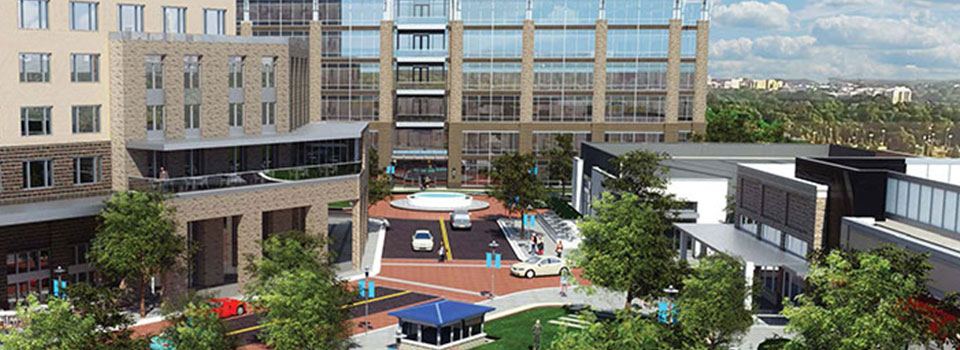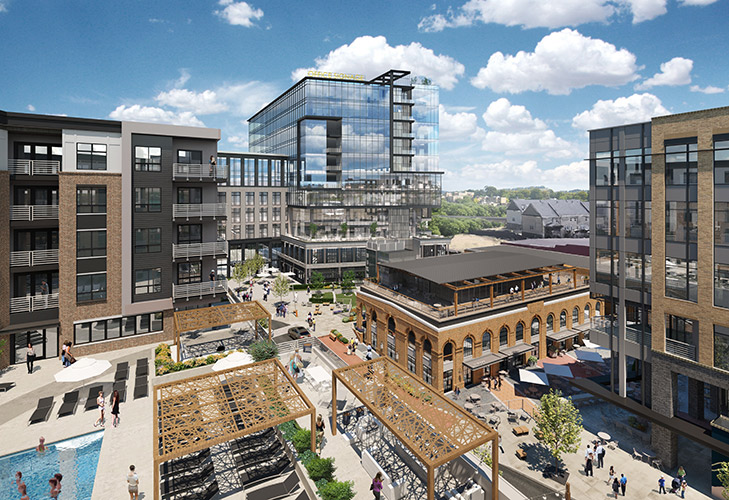New partner at Crosland Southeast weighs in on Waverly, industry trends

Real Estate Notes: One Bellevue Place lands Burlington
July 12, 2016
Four Healthcare Tenants Announced for Waverly Development
July 18, 2016July 18, 2016 – Ashley Fahey
Staff Writer
Charlotte Business Journal
Five years have now passed since Charlotte real estate firm Crosland Southeast was formed.
The locally based development company launched in 2011, after the retail division of Crosland LLC spun off to become Crosland Southeast and CNL Commercial Real Estate, now Foundry Commercial. Crosland Southeast’s five founding partners — Peter B. Pappas, Tim Sittema, Mike Wiggins, James Downs and Austin Williams — were all officers at Crosland LLC.
Since its inception, Crosland Southeast has grown its team from nine to 24 employees. The retail-focused firm has $300 million-plus of construction underway across several southeastern states.
Coinciding with the five-year anniversary is the naming of a sixth partner. Barry James, who leads the company’s design, development and construction portfolio, is the first new partner to be named since Crosland Southeast was formed.
James — who has worked in Charlotte commercial real estate for 16 years at Crosland Southeast and, beforehand, at American Asset Corp. — is managing several prominent Crosland Southeast projects. That includes the 90-acre Waverly project, developed in partnership with Childress Klein and longtime land owners the Matthews family, at the intersection of Providence and Ardrey Kell roads. When built out, the mixed-use development will include 250,000 square feet of retail, two six-story office buildings, two medical office buildings, a 375-unit apartment project called Solis Waverly, and 150 single-family homes and townhouses by David Weekley Homes.
Outside of Charlotte, James is spearheading one of the largest projects outside the urban core in Nashville, Tenn. — the Bellevue Mall redevelopment. That $200 million project, called One Bellevue Place, will include 350,000 square feet of retail, 337 apartments, a 111-room Hilton hotel and up to 300,000 square feet of office space.
At Waverly, several retail tenants, including a 40,000-square-foot Whole Foods Market anchor, have been announced since its groundbreaking last summer. The development’s first speculative office building will soon break ground.
James recently spoke with the Charlotte Business Journal about Waverly, creating a sense of place in real estate projects and what trends are currently driving the industry.
How have design and construction trends and industries evolved since you started?
Relative to retail and mixed-use, one of the biggest changes has been (what’s) called outdoor place-making and outdoor living room areas. As you look at what people want to do and as people become a little more remote with technology, creating places that draw people together becomes more unique and special. For instance, in our Waverly project, we have what’s called the terrace, which is really going to be the focal point of the entire project. It’s less than one acre, but it’s meant to pull the community together and create that sense of place. Design styles come and go, but really good design and thoughtful design will stand the test of time.
How do you create a sense of place?
We start with that sense of place. It doesn’t become, “Here’s the design and, oh, we can fit it in here.” It really becomes the focus of what we want to do. We start with what functions want to occur within that area, what size and scale best fit for the project, how do we activate it … and then we design around that. At Waverly, we wanted (the sense of place) to be centralized within the project. We then designed the buildings around it and we put it in a location where it will serve the office, multifamily, residential and retail — it doesn’t just serve the retail.
A big part of it for us is the tenant mix. What activates an area is what’s adjacent to that area. When you look at the evolution of design and projects, you’re having a lot more (demand for) quick-serve restaurants. That’s becoming a real shift within the retail market. You used to have 300 square feet of patio area. Now we’re getting requests for 1,200 square feet of patio. How you start to activate that area? It can’t all be controlled by design; it becomes about how you activate it and what you put adjacent to that area. In Waverly, we have a green space area that can serve (multiple uses): kids can run around; we’re going to have two fountains — one interactive fountain, one that’s just a focal point or more sculptural. We’re trying to find a variety of seating that provides options for people on how they want to experience (the space).
What does the future look like for master-planned, mixed-use development? Do you see a lot changing?
It always evolves. You’re going to see a higher concentration — we’re seeing denser projects, we’re seeing more infill projects. The projects go where the people live and you’re seeing more people coming into city centers. You’re having a migration back to the city versus out to the suburbs. You’re going to see more opportunities to do infill projects. We’re doing those projects now, but you’re going to see denser projects and probably more mixture of uses, such as more medical within projects.
What is the latest news at Waverly? Is anything coming down the pipeline soon?
On Aug. 15, we turn over Whole Foods and they start their interior work. They have up to six months to do that … they’re targeted to open in the middle of February. We expect we’ll be turning over the other buildings in August and September, and we expect the other tenants to be opening around the same time. Within 30 days, we expect to be 85% leased on the project. Next month, we’ll start construction on the first office building, which serves as an anchor to the retail project on the southern end — that’s a 150,000-square-foot, six-story office building. We aren’t developing the hotel, but the operator has already started construction. There’s a lot of activity over there and very excited about where we’re at (with the development).
As a company, what types of projects will Crosland Southeast likely be doing more of moving forward?
(More) urban infill projects would be exciting. We’ve done it in suburban locations where (our) projects have served as a catalyst to revitalize a community. To do those higher-density projects in an urban infill location I think would be pretty exciting. We expect we’d be doing more of that, given the trends.
Click here to read the original article in the Charlotte Business Journal.



